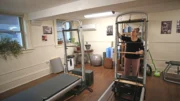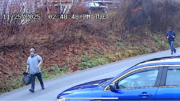The signs that summertime is coming are really beginning to show.
“One lane road ahead”
“Expect delays”
“Detour”
“Be prepared to stop”
All signs that lead our brains to be consumed by our soon-to-be inconvenienced self-absorption. As if this sign was meant for us and us alone. As if it were put there to make our day lousier than it already was or to ruin a perfectly good mojo we were experiencing.
These signs interfere with our simple desire to get from point A to point B hassle-free and as quickly as possible.
“Flagger ahead”
Earlier this week, I listened to a young woman talk about how she was severely injured and her mom and dad died because a young driver on a cell phone blew through a stop light, causing another vehicle to swerve into them.
You might say road safety has been on my mind since.
That “flagger ahead” sign means someone’s daughter or son, husband or wife, friend, cousin, mom or dad is up ahead.
They are there to provide us with some guidance to get through a construction site safely with all that heavy equipment and people paying attention to their jobs.
And the flagger is there to protect those workers on the job as well.
Workers who are making the road we travel on a safer, smoother and better surface. Work that, if not done, would likely cause us to curse the Department of Transportation or a municipality for the awful condition of the road. Not to mention the inconvenience of car repairs and possibly unsafe roads that cause us to lose control and get in accidents.
Today, I chatted with Charles Cook who was working the slow/stop sign at one end of a fairly short section of the construction along the four-mile stretch of 322 that will be under construction all summer and into the fall. While there in my safety vest with dust from the road, grinding and blowing into my allergy-riddled nose, the cars seemed to be going fast. I asked Charles how fast he thought they were going?
“About 30,” he said.
I thought, when I’m driving, 30 mph seems like I’m crawling. But out there on the side of the road, well actually, in the little bit of road where the white line and edge of the pavement used to be on this torn up road, those cars seemed to be going dangerously fast.
“The traffic just needs to slow down,” Cook said. “People need to pay attention.”
I agree brother, I thought!
PennDOT says the speed limits in construction zones don’t change unless specifically posted. But PennDOT spokesman Jim Carroll said motorists have the responsibility to drive according to the conditions. He said a speed limit might be 65 mph but if it’s foggy it’s likely a driver would slow down. He said the same is true with construction sites, that drivers should slow down and drive safely according to the conditions.
In their press releases, PennDOT issues this statement: “PennDOT urges motorists to slow down when driving in work zones and also to be alert to changing conditions, avoid distractions and to pay attention to signs and flaggers. Drive responsibly in work zones for your safety and the safety of the workers.”
As I think more about this, I also realized I am out in these sites fairly often during the course of the spring, summer and fall, as well as responding to accidents.
Just last week on an accident call, I was putting on my safety vest (which I complained about needing when it became law) when I heard the screaming tires of a car that somehow managed to stop inches from crashing into the cars that had already been stopped by a fireman who was put on emergency traffic control duty.
Roads are dangerous.
I remember my dad putting me behind the wheel of his car for the first time after I got my driver’s permit. He told me driving a car is like owning a loaded gun (a strange thing to hear considering my dad didn’t own a gun.) He said they are dangerous but if used responsibly they are an incredibly valuable tool. (My dad’s a pretty smart man – he also told me that day that when you shut your car off, even if you’re planning on sitting in the car, take the keys out of the ignition and put them in your pocket. This is a lesson I repeat to all my friends who repeatedly seem to lock their keys in the car. It’s brilliant advice! Thanks, dad!)
Back to construction sites and road safety.
When I come up on that first sign that says road construction ahead, I’ll admit I have that same upset reaction as everyone else. If I’m late, I’m likely to even blurt out profanities at my windshield and even bang my steering wheel as if it were its fault that I forgot this road I’ve been traveling on the last month has been under construction and somehow is still under construction on this day that I’m late. That for some reason, because I’m late, the construction company was so inconsiderate to not decide to not work today so I could … well … still be late, but maybe not quite as late.
The simple thing is, I may feel inconvenienced and even a little upset when I come upon a construction site, but these good folks doing their work at the construction site shouldn’t have to be dragged down into my bad day.
Nor should their family and friends by my negligence.
Be safe.
Note: All photos are digitally altered illustrations. All color, other than the safety gear, has been removed.
(On an even more personal note, I feel like an idiot putting on a safety vest and hard hat because I’m a photographer and not one of the physically demanded workers on the site. But I do it in part because it’s the law now, it’s a PennDOT rule to be in the construction zone and because I feel I’m showing respect to the workers by at least complying to the work-zone rules of safety.
Annnnnnnd … because its smart to be as safe as one can be in a dangerous place.
I wave to the flaggers when I pass to say thanks for helping me pass safely. I have no idea if they know why I’m waving, but I do. They are in a very dangerous position and often have to put up with pretty grumpy and sometimes unreasonable folks.)
If you don’t believe me, visit this site for how dangerous work sites can be: safety.fhwa.dot.gov.
It includes the following facts plus a lot more! This should be required reading for everyone – and perhaps so should “stopped in traffic’ meditation lessons.”
Facts
- During the past 5 years in work zone crashes more than:
- 4,400 persons died (85 percent of which was the driver or passenger)
- 200,000 persons were injured
- Drivers are the most frequent fatality in work zone crashes
- Most work zone fatalities involve working-age adults
- Rear-end crashes (running into the rear of a slowing or stopping vehicle) are the most common type of work zone crash.
- Fatal work zone crashes occur most often in summer and fall
- The majority of fatal work zone crashes occurred on roads with speed limits greater than 50 mph.
- Stopping distance for motor vehicles at 50 mph:
- Dry roadway~300 ft
- Wet roadway~400 ft
- Icy pavement~1250 ft
- A loaded 80,000 lb tractor-trailer requires almost 50% more stopping distance
- It takes only an extra 25 seconds to cover 1 mile at 45 mph compared to 65 mph





































